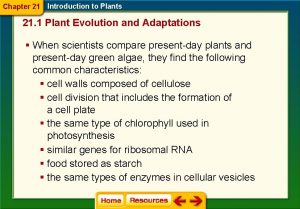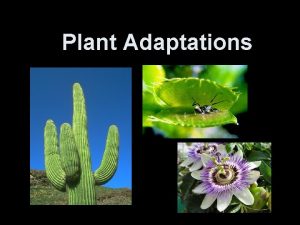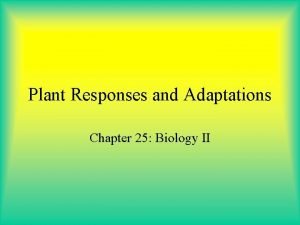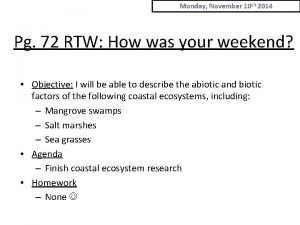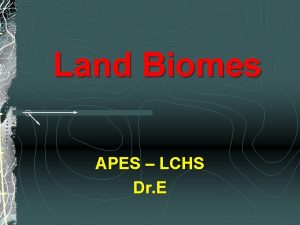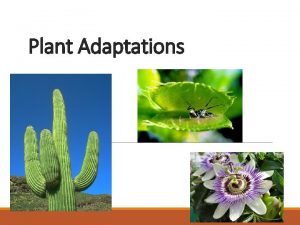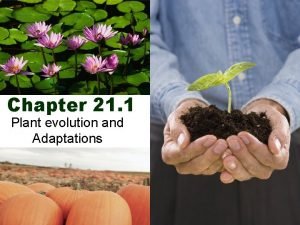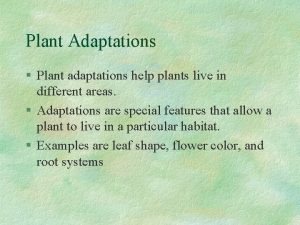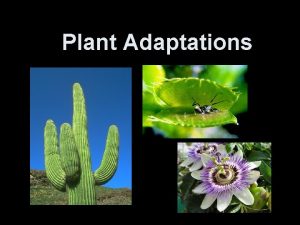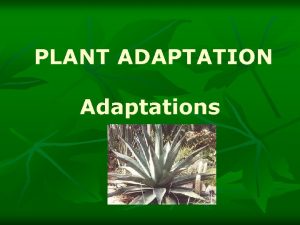PLANT ADAPTATIONS C 3 Plants C 4 Plants










- Slides: 10

PLANT ADAPTATIONS • C 3 Plants • C 4 Plants • CAM Plants • Heterotrophic Plants

PLANT EVOLUTIONARY HISTORY • Life began in water • The first plants were aquatic • When plants moved to land, they had a difficult time dealing with dehydration this lead to many adaptations that reduced transpiration and preserved water. – Stomata are necessary for gas exchange, but increase transpiration rates. (Trade-offs)

C 3 PLANTS most plants • Fix carbon by attaching CO 2 to Ru. BP using the Calvin Cycle • On hot days, they close their stomata part way (which limits sugar production, but minimizes water loss)

PHOTORESPIRATION…nooo! - a process that occurs in the light; consumes oxygen and releases CO 2 • When a C 3 plant uses up the CO 2, Rubisco will “fix” or take in O 2 and send it to the Calvin Cycle instead of CO 2 • This process DECREASES the production of glucose – since there is no carbon to make sugars. • Photorespiration uses up the ATP a wasteful process!

So why would any plant do this? ? • Photorespiration may be an evolutionary “leftover” • In the early atmosphere with little to no oxygen, it didn’t matter if Rubisco had an affinity for O 2 • Today, with so much O 2 in the atmosphere, it is inevitable that some O 2 will be fixed instead of CO 2 C 3 crop plants include Rice, Wheat, Soybeans. - They may lose as much as 50% of the carbon fixed in the Calvin cycle to photorespiration

C 4 PLANTS and CAM PLANTS Both types of plants have evolved adaptations For alternate methods of carbon fixation in hot, arid climates. • Their stomata stay closed during the day and open at night. • This limits water loss but it also limits the CO 2 that diffuses into the leaf for photosynthesis. Solution? They store CO 2 (in organic acid form) for later use! Uses PEP Carboxylase before the Calvin cycle to make organic acids

C 4 PLANTS • These plants “fix”CO 2 to a molecule called PEP (phosphoenolpyruvate), using an enzyme called PEP carboxylase, into a an organic acid • PEP has a high affinity for CO 2 and none for O 2 • The organic acid molecule later releases CO 2 from PEP and the Calvin Cycle continues as normal. • This adaptation allows C 4 plants to keep a high concentration of CO 2 – and prevents photorespiration! • C 4 examples: sugarcane, corn, and tropical grasses • They thrive in hot climates where their stomata will be closed often.

CAM PLANTS • CAM plants keep stomata closed during the day to minimize water loss; they only open at night • This means no CO 2 can enter during the day! • CAM plants take in CO 2 at night and fix it into organic molecules this is referred to as Crassulacean Acid Metabolism • CAM plant examples: pineapple, agave, succulent plants • CAM adaptations loses the least water and has the lowest amount of photorespiration compared to C 3 and C 4 plants

HETEROTROPHIC PLANTS • These plants live in environments that require adaptations which allows them to supplement their nutrition and minerals (especially nitrogen) Parasitic Plants (Parasites) These harm their host by siphoning nutrients and minerals from it. (The parasite fuses their xylem with the host!) Carnivorous Plants These plants “eat” insects and other nitrogen rich organisms. - They typically live in acidic environments that have low nitrogen in the soil due to low decomposition rates. VENUS FLY TRAP

Examples of Parasitic Plants: Examples of Carnivorous Plants: PITCHER PLANT MISTLETOE DODDER
 Anthocerophytes
Anthocerophytes Adaptation of lotus
Adaptation of lotus Temperate deciduous forest plant adaptations
Temperate deciduous forest plant adaptations Chapter 21 section 1 plant evolution and adaptations
Chapter 21 section 1 plant evolution and adaptations Chapter 25 plant responses and adaptations answer key
Chapter 25 plant responses and adaptations answer key Temperate forest average precipitation
Temperate forest average precipitation Salt marsh plant adaptations
Salt marsh plant adaptations Deciduous forest abiotic factors
Deciduous forest abiotic factors Temperate grasslands animal adaptations
Temperate grasslands animal adaptations Grassland adaptations for plants
Grassland adaptations for plants Coniferophyta
Coniferophyta
